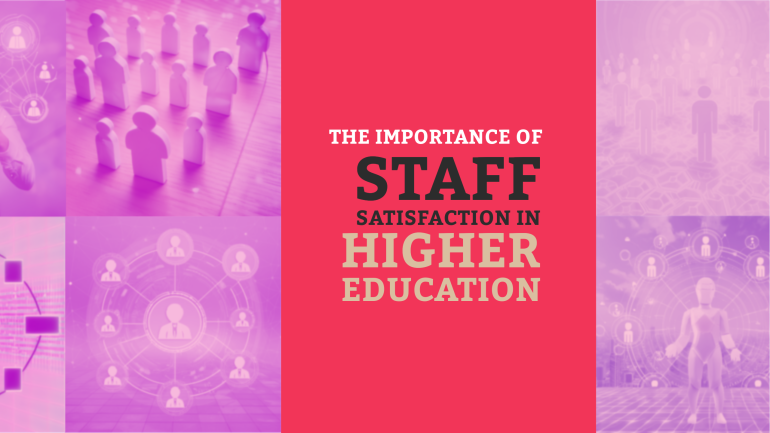Table of Contents
TL;DR: The Importance of Staff Satisfaction in Higher Education
- Staff satisfaction is crucial in higher education for creating a positive work environment and fostering a culture of collaboration and innovation.
- Happy staff members are more likely to be productive, engaged, and motivated, leading to better student outcomes and overall success for the institution.
- Investing in staff well-being through training, professional development opportunities, recognition programs, and work-life balance initiatives can have a significant impact on their satisfaction levels.
- Effective communication between staff and administration, as well as a transparent decision-making process, can enhance trust and morale within the institution.
- Regular feedback mechanisms such as surveys, focus groups, and one-on-one sessions can help identify areas of improvement and address concerns promptly to boost staff satisfaction.
You may have heard about student satisfaction being a critical factor in the educational sector, but have you ever considered the immense impact of staff satisfaction within higher education institutions? This often-overlooked aspect plays a key role in the overall success and reputation of an academic institution. Happy and engaged staff members not only contribute positively to the learning environment but also enhance the quality of education and student experience. Conversely, low staff satisfaction can lead to higher turnover rates, decreased productivity, and a negative impact on the institution’s reputation. Let’s research deeper into why prioritizing staff satisfaction in higher education is imperative for the success and well-being of everyone involved.
The Impact of Staff Satisfaction on Institutional Performance
Academic Excellence and Reputation
Now, academic excellence and reputation play a significant role in the overall performance of higher education institutions. An institution’s reputation often stems from the quality of its academic programs, faculty, and research output. When staff members are satisfied, they are more likely to be engaged in their work, leading to enhanced teaching quality, impactful research contributions, and a positive academic environment that attracts talented students and other faculty members.
Financial Stability and Resource Allocation
Now, stability in financial matters and efficient resource allocation are crucial components of an institution’s success. When staff members are satisfied in their roles, there is a higher likelihood of a stable work environment and lower staff turnover rates. This stability can lead to better financial management practices, as well as effective allocation of resources towards critical areas such as infrastructure, technology, and faculty development.
Stability in financial matters can directly impact an institution’s ability to invest in new programs, facilities, and initiatives that can elevate its overall performance and reputation. Additionally, a stable work environment can foster a culture of innovation and collaboration among staff members, ultimately contributing to the institution’s long-term success.
Reputation is a key factor that can make or break an institution in the competitive landscape of higher education. A positive reputation can attract top students and faculty, leading to increased funding opportunities and partnerships. Conversely, a negative reputation stemming from issues such as low staff satisfaction can have far-reaching consequences, affecting recruitment efforts, donor support, and overall credibility in the academic community.
Factors Influencing Staff Satisfaction in Higher Education
Clearly, there are several factors that play a crucial role in determining the satisfaction level of staff in higher education institutions. Understanding and addressing these factors is crucial in fostering a positive work environment and retaining talented faculty and staff members. Let’s explore some key influencers in staff satisfaction.
Leadership and Management Practices
Higher education institutions must prioritize effective leadership and management practices to ensure staff satisfaction. Clear communication, supportive leadership, and opportunities for professional development are key aspects that influence how staff members feel about their workplace.
Work Environment and Collegial Relationships
Influencing staff satisfaction are the work environment and collegial relationships within the institution. A positive and inclusive work environment where collaboration and support are encouraged can significantly impact staff morale and job satisfaction. Effective communication and mutual respect among colleagues also play a vital role in creating a harmonious workplace.
Staff satisfaction in higher education is greatly influenced by factors such as leadership practices, work environment, and collegial relationships. Addressing these factors can lead to a more productive and positive work environment, ultimately benefiting both staff and the institution as a whole.
Strategies for Enhancing Staff Satisfaction
Professional Development Opportunities
An vital strategy for enhancing staff satisfaction in higher education is providing professional development opportunities. This includes access to workshops, conferences, and training programs that allow staff to expand their skills and knowledge. Professional development opportunities are crucial in helping staff stay motivated, engaged, and up-to-date with the latest industry trends. By investing in the growth and development of your staff, you demonstrate a commitment to their professional advancement, which can boost morale and retention rates.
Recognition and Reward Systems
Rewarding and recognizing staff for their hard work and contributions is another vital strategy for enhancing staff satisfaction. Recognition and reward systems show appreciation for staff efforts, motivating them to continue performing at their best. This can include public acknowledgments, bonuses, promotions, or other forms of incentives that acknowledge and celebrate their achievements. It is important to create a fair and transparent system that values and rewards both individual and team accomplishments.
Moreover, recognition and reward systems can help create a positive work culture, increase employee loyalty, and reduce turnover rates.
The Importance of Staff Satisfaction in Higher Education
Surveys and Feedback Mechanisms
Many higher education institutions understand the significance of measuring and monitoring staff satisfaction. Staff engagement surveys and feedback mechanisms play a crucial role in gathering valuable insights into the overall satisfaction levels of employees. These tools help in identifying areas of improvement and addressing issues that may impact staff morale.
Data-Driven Approaches to Improvement
To effectively enhance staff satisfaction in higher education, institutions must adopt data-driven approaches to improvement. By analyzing survey data and feedback, institutions can pinpoint specific areas that require attention and implement tailored strategies to drive positive change. This method allows for measurable outcomes and enables continuous growth in staff satisfaction levels.
Case Examples of Successful Satisfaction Initiatives
Innovative Programs and Policies
For higher education institutions, implementing innovative programs and policies to enhance staff satisfaction has proven to be a successful strategy. By introducing flexible work arrangements, professional development opportunities, and wellness programs, universities can create a supportive and engaging work environment that fosters staff satisfaction. These initiatives not only improve morale but also contribute to increased productivity and job satisfaction.
Impact on Retention and Recruitment
On the topic of retention and recruitment, prioritizing staff satisfaction has shown remarkable results in higher education. Institutions that invest in their staff’s well-being and professional growth experience lower turnover rates and higher recruitment success. Employees are more likely to stay and recommend their workplace to others when they feel valued and supported. This not only saves costs associated with recruitment and training but also enhances the institution’s reputation as an employer of choice.
Programs such as mentorship initiatives and recognition programs further reinforce a positive organizational culture and contribute to building a loyal and motivated workforce. By focusing on staff satisfaction, higher education institutions can attract top talent, retain experienced staff, and ultimately thrive in a competitive academic landscape.
Conclusion
As a reminder, staff satisfaction plays a crucial role in the success of higher education institutions. Happy and fulfilled employees are more engaged, productive, and likely to provide quality service to students. Investing in staff satisfaction leads to a positive work environment, lower turnover rates, and ultimately, better academic outcomes. It is necessary for higher education leaders to prioritize the well-being of their staff to create a thriving and successful institution.
FAQ
Q: Why is staff satisfaction important in higher education?
A: Staff satisfaction is crucial in higher education as it directly impacts the quality of education, student experience, and overall performance of the institution.
Q: How does staff satisfaction affect the retention of talented faculty members?
A: High staff satisfaction levels lead to higher retention rates of talented faculty members, reducing turnover costs and maintaining institutional knowledge and continuity.
Q: What are some strategies that higher education institutions can implement to improve staff satisfaction?
A: Institutions can improve staff satisfaction by fostering a positive work culture, providing professional development opportunities, offering competitive compensation and benefits, and promoting work-life balance.
Q: How does staff satisfaction impact student success in higher education?
A: Satisfied staff members are more engaged, motivated, and productive, which directly benefits students through improved teaching quality, mentorship, and support services.
Q: What are the long-term benefits of prioritizing staff satisfaction in higher education?
A: Prioritizing staff satisfaction leads to higher faculty morale, increased productivity, enhanced institutional reputation, and ultimately, a positive impact on student recruitment, retention, and success rates.




